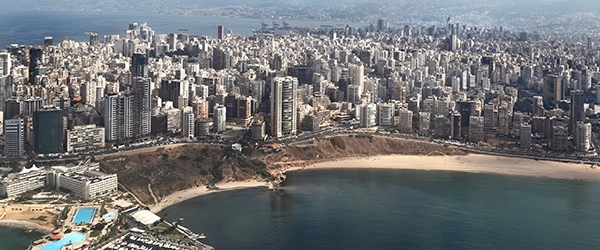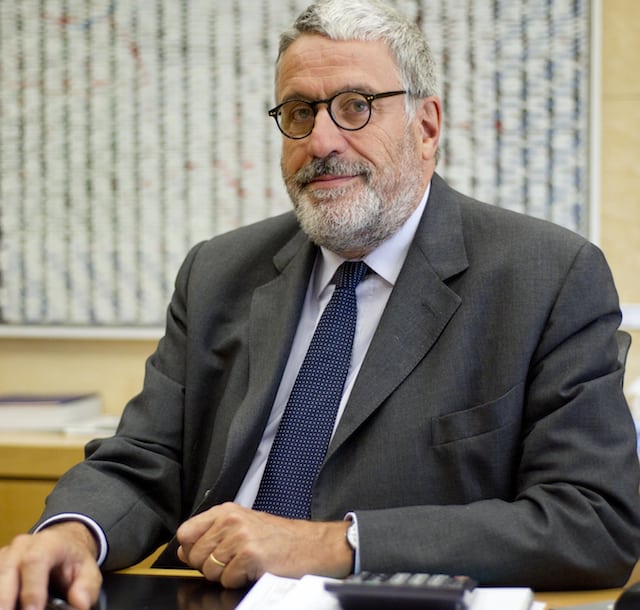Regional Focus | The Levant

Offshore energy reserves, a stable banking sector and infrastructure gaps all present opportunities for foreign investment in the Levant region.
At first glance the Levant in late 2014 hardly seems a natural fit for large-scale foreign investment. Almost all of the 11 (if you include the entire eastern Mediterranean coastline from Greece to Egypt) countries that make up this historic, though not always consistently defined, region, are in crisis. But notwithstanding all the big political issues plaguing most of the countries in the Levant, there is growth: Foreign direct investment is growing, and so are investments in infrastructure in some countries.
The political challenges can seem daunting: To the west, Egypt is recovering from its disastrous experiment with democracy, as president Abdel Fattah al-Sisi attempts to restore order and growth and investment to the economy. In the middle, still-divided Cyprus is reeling from the financial shocks that brought it near collapse last year, with domestic bank nonperforming loans constituting over 50% of portfolios and GDP this year to contract further after a 5.4% contraction last year (see sidebar). To the east, the brutal civil wars in Syria and Iraq continue with no conclusion in sight, as Western and Arab forces cooperate to oppose Sunni Islamic militant group ISIS. Meanwhile, Lebanon and Jordan continue to suffer from the impact of the fighting, with Jordan hosting almost one-and-a-half million displaced Syrians and 300,000 Iraqis; Jordanian Finance minister Umayya Toukan has said that refugees now cost Jordan $3 billion a year, or 25% of its budget expenditure. Lebanon has well over a million Syrian refugees, against a native population of just 4.5 million, the highest proportion in the world. Little wonder that infrastructure and finances in both countries are at the bursting point, with near-record deficits and growing indebtedness; this year, Jordan anticipates a current-account deficit of around 10% and Lebanon, 16%.
Since the start of the Arab Spring in 2011 {through} August 2014, Lebanon has attracted some $56 billion in net inflows – that’s 18.5% of the total inflows into the MENA region when our GDP is just 1.4% of the MENA total.
~ Freddie Baz, Bank Audi
Despite these negatives and the uncertainty facing almost all the countries, there are silver linings. “Increasingly, there is a clear external commitment to support these economies in recognition of the problems they face,” says Paul Gamble, director of the Sovereign Group at Fitch Ratings. “Egypt, Jordan and Lebanon are getting a lot of assistance from the Gulf and the West, with IFIs [international financial institutions] playing a growing role.”
GDP has grown here by more than one would have expected. Egypt saw Q2 growth of 3.7%, proof the economy is returning to life, while the European Bank For Reconstruction and Development (EBRD) expects Jordan to grow 3.4%, led by mining, agriculture and utilities. Lebanon should also see growth, although the 1% to 2% forecast is a far cry from pre-crisis levels of 8% to 9%.

“Lebanon continues to suffer, not just from the impact of the war in neighboring Syria but from the gridlocked political situation,” says Jason Tuvey, emerging markets analyst at the consultancy Capital Economics. “The country is still without a president or an effective economic strategy. Government debt has now hit 140%, while the primary budget [the budget excluding interest payments] has slipped into deficit for the first time since 2001.”
Yet those on the ground see things another way. “There is a difference between perceptions and the reality,” argues Freddie Baz, Bank Audi’s CFO and strategy director.
Lebanon has a dynamic bank sector that continues to finance government and attract deposits from residents as well as Lebanon’s large and wealthy expatriate community (remittances are currently around $8 billion a year, equivalent to around 20% of GDP). By the end of July 2014, total Lebanese bank assets had risen 7.6% over July 2013, to reach just under $170 billion.
Baz says: “Since the start of the Arab Spring in 2011 [through] August 2014, Lebanon has attracted some $56 billion in net inflows—that’s 18.5% of the total inflows into the MENA [Middle East and North Africa] region—when our GDP is just 1.4% of the MENA total.”
Bank Audi’s strategy has typified that of many of the more proactive banks here. It has substantially deleveraged from Syria, where $10 billion of outstanding loans in December 2010 has dropped to just $100 million—something Baz affirms as proof of the bank’s successful risk management policies. At the same time, business in Egypt, essentially on hold during the tumultuous presidency of Mohamed Morsi, is now being ramped up again in recognition of that huge market’s potential, especially with so many infrastructure projects in the pipeline. Yet, despite the country’s having had three presidents in two years and having experienced economic upheaval, Bank Audi’s Egyptian NPLs are just 2.6% of the total.
As well as Egypt and Lebanon, who both make up Bank Audi’s core market, Turkey is the other big prize. In the two years since it opened, Bank Audi’s Turkish subsidiary, Odeabank, has seen annual revenues that topped $10 billion—equivalent, Baz says, to 80% of HSBC or ING’s revenues, and those established banks have been in the Turkish market for more than 20 years.
Increasingly, there is a clear external commitment to support these economies in recognition of the problems they face.
~ Paul Gamble, Fitch Ratings
Across the region far-sighted banks, companies and investors are increasingly looking for opportunities. In Egypt huge infrastructure projects are planned, including a widening of the Suez Canal, new roads and railways, desalination plants, housing and even a new administrative capital to the east of Cairo—all part of al-Sisi’s “Map of the Future.” Jordan is proceeding with a 2000MW, $10 billion nuclear power plant to help alleviate its long-running energy shortage. The plant, to be constructed by Russia’s Rusatom Overseas, will be one of the country’s biggest-ever investments; by 2020 it is expected to provide 12% of Jordan’s energy.
Meanwhile Emaar, one of the UAE’s biggest companies, which has already constructed the multipurpose Samarah Dead Sea Resort not far from Amman, is looking at new projects in Jordan, as well as an ambitious $3 billion multipurpose project in Iraqi Kurdistan.
The list continues. Kuwait-based Zain Group has been investing in telecoms; SAP, one of the world’s largest enterprise software companies, has been doing likewise. It has 10 offices in its MENA division. The new Beirut Digital District, meanwhile, is starting to thrive, with some 13 tenants and a number of new upcoming projects.
RISING FDI

Little wonder then, that despite all the problems, foreign direct investment in the Levant increased dramatically last year over 2012. Jordan saw inflows of $10.9 billion against $1.3 billion, and Iraq, $15 billion against $950 million. FDI will rise dramatically once the full exploitation of the Levantine Basin gets under way. Israel is currently the only country commercially extracting and selling gas, but Cyprus (assuming agreement can be reached between Greek and Turkish Cypriots) and eventually Lebanon (once its politicians pass the necessary legislation) should benefit from what geologists say could be as much as 3.5 trillion cubic meters of gas and some 1.7 billion barrels of oil. The development of these reserves will invariably give rise to support industries and services. But observers warn that even though these reserves are economically viable to extract, it will take a lot of time for the benefits their development will generate to filter through.
“Particularly for Lebanon, there are a lot of caveats before we can talk about what the gas industry might look like in five or six years time,” says David Butter, Levant expert for Chatham House in London.
So aside from Egypt, which most observers agree has begun the long journey back to sustainable economic growth, which Levant area economy currently shows the most promise?
Perhaps surprisingly for a country bordering both Iraq and Syria, one that has seen almost all its traditional trade routes disrupted by war, Jordan is the prime candidate. Its prospects are improving, underpinned as they are by strong international support and domestic reforms. Among the latter has been the gradual elimination of electricity subsidies, with the aim of bringing tariffs to cost recovery levels by 2016. This has helped bring the deficit down, although it is still around 8% of GDP.
“Growth (in Jordan) next year should reach 4.1%, led by a gradual improvement in both domestic and foreign investment,” says Hanan Morsy, senior regional economist in charge of the southern Mediterranean region, EBRD.
Jordan’s economy has benefited enormously from free zones, specifically the 370 million-square-meter Aqaba Special Economic Zone, located near that city’s international airport and close to the borders of Israel, Egypt and Saudi Arabia. It has already attracted well over $20 billion in foreign capital, with an oil terminal, a new port, new hotels, restaurants and housing all part of the ongoing development in this Red Sea hub, alongside the SME-focused Aqaba International Industrial Estate. The government is prioritizing investment in the energy sector, infrastructure and small business, confident that the measures it is also putting in place to improve the business environment will further encourage foreign investment inflows.
“Investors are coming back because—by the standards of the region—Jordan is seen as politically stable,” says Capital Economics’s Tuvey. “However, normal levels of growth will not return, either here or in Lebanon, until there is a clear improvement in the crises in neighboring Iraq and Syria.”
Economic Indicators, SELECT Levant Countries |
|||||
|---|---|---|---|---|---|
Country |
GDP (% change), constant prices |
GDP, current prices ($bn) |
Inflation (% change) |
FDI Inflows ($mn) |
|
|
|
2013 |
2014* |
2013 |
2013 |
2013 |
|
Cyprus |
-5.4 |
-3.2 |
21.9 |
0.4 |
533 |
|
Egypt |
2.1 |
2.2 |
271.4 |
6.9 |
5,553 |
|
Israel |
3.2 |
2.5 |
290.6 |
1.5 |
11,804 |
|
Jordan |
2.9 |
3.5 |
33.9 |
5.6 |
1,798 |
|
Lebanon |
1.5 |
1.75 |
45 |
3.2 |
2,833 |
|
Sources: GFMag.com economic reports, IMF, UNCTAD *estimate |
|||||



